Dietary Supplement Labeling Guidelines Explained
A practical guide to dietary supplement labeling guidelines. Learn to create compliant labels that meet FDA rules and build consumer trust.
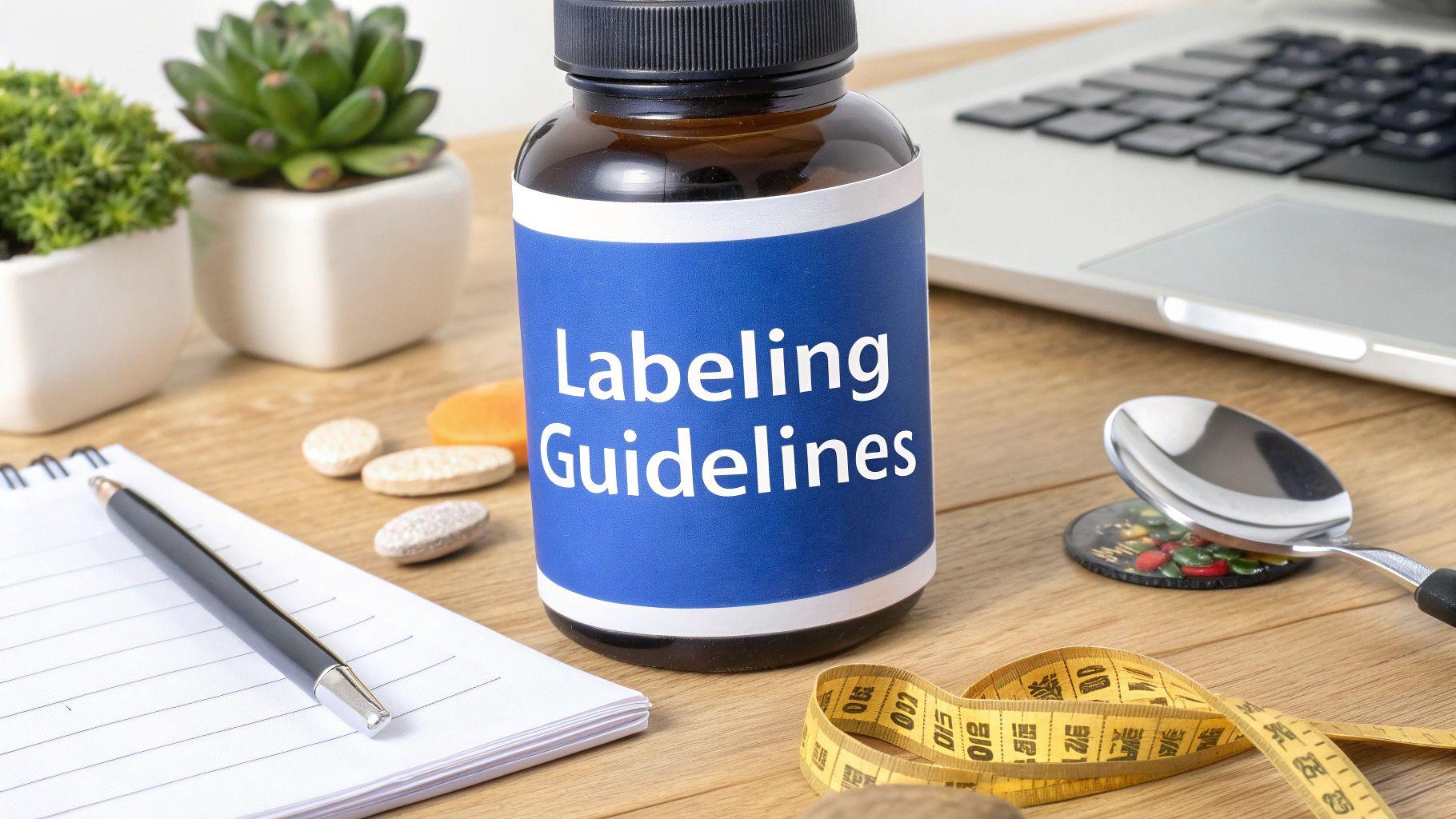 Get a Free Quote Today!
Get a Free Quote Today!Getting your supplement label right isn't just a design task—it's a legal minefield. The FDA's dietary supplement labeling guidelines are the absolute rulebook. If you want to succeed in the market, build consumer trust, and sidestep some seriously expensive penalties, you need to know these rules inside and out.
Understanding Dietary Supplement Labeling Regulations
Trying to decipher dietary supplement labeling regulations can feel like reading a foreign language, but the stakes couldn't be higher. The rules are incredibly strict, and one small mistake can have massive repercussions for your business. We're not just talking about a slap on the wrist; we've seen the real-world consequences of non-compliance like product takedowns on major e-commerce platforms.
The law that shapes this entire landscape is the Dietary Supplement Health and Education Act (DSHEA) of 1994. This was a landmark piece of legislation. Before DSHEA, supplements were often treated like food additives, but this act carved out a unique regulatory space for them, setting them apart from conventional foods and drugs. You can get the full story straight from the source on the official FDA website for dietary supplements.
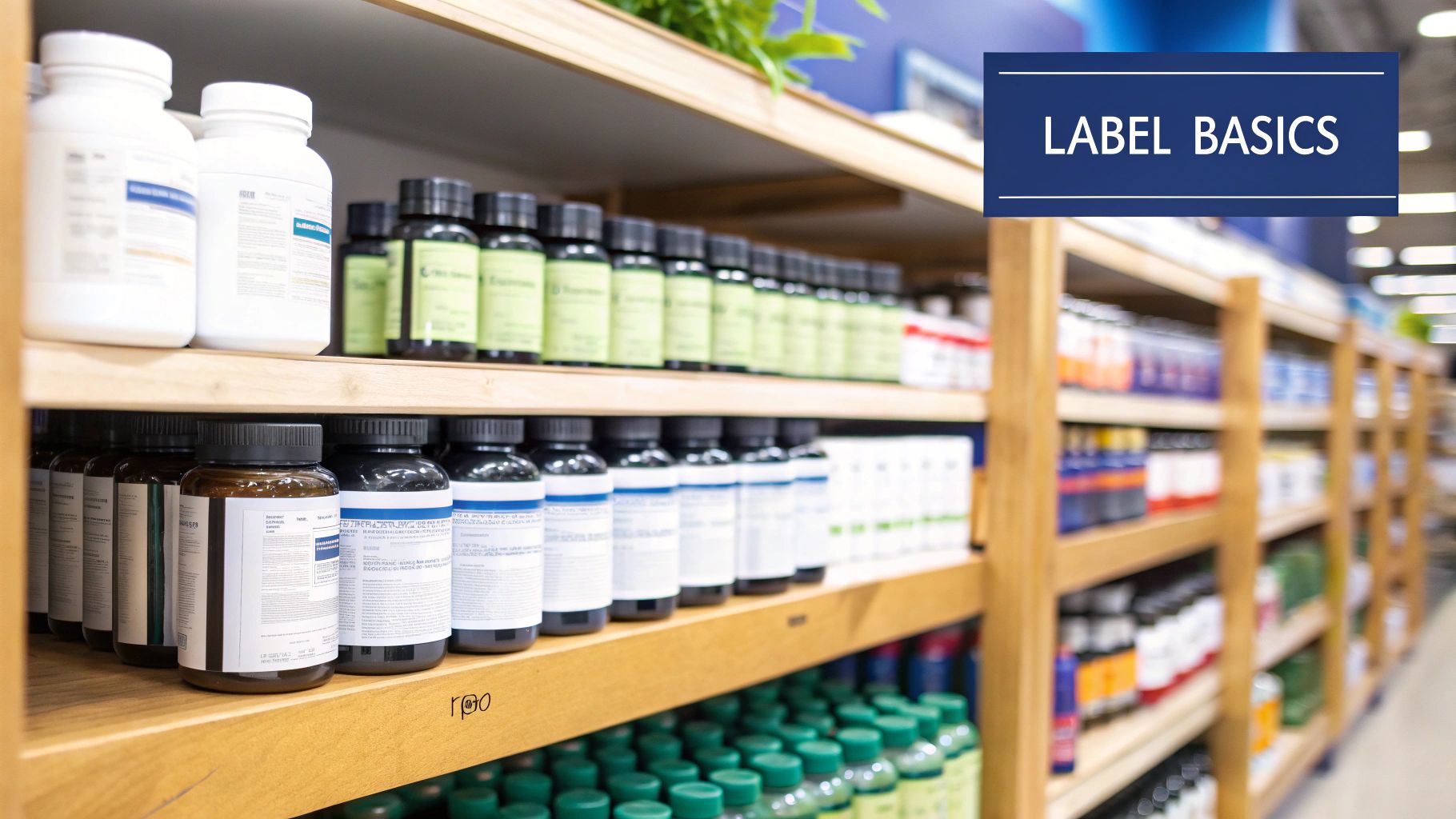
This snapshot from the FDA’s site shows the resources they provide, but it also sends a clear message. While the FDA doesn't approve your label before you go to market, they are absolutely watching and will enforce the rules once your product is on the shelf.
The Foundation Of A Compliant Label
Think of DSHEA as establishing the non-negotiables for your label. These are the absolute must-haves, the foundational elements of compliance. Every single dietary supplement sold in the U.S. has to display these five mandatory statements, no exceptions.
Here’s what you need:
- The Statement of Identity: What is the product? Be specific (e.g., "Herbal Supplement," not just a brand name).
- The Net Quantity of Contents: How much of the product is inside the package.
- The Supplement Facts Panel: The detailed nutritional information per serving.
- The Ingredient List: A full list of every single ingredient.
- The Name and Place of Business: Who is responsible for this product? This must be the manufacturer, packer, or distributor.
The whole point of these five elements is to give consumers clear, standardized information. It allows them to make smart choices and accurately compare one product to another. Getting any of these wrong isn't just a simple mistake; it's a direct violation of federal law.
Why Compliance Goes Beyond The Label
Here's something a lot of new brands miss: compliance isn't just about what you print. It’s a reflection of your entire operation. Your label makes a promise, and that promise has to be backed up by your formulation, quality control, and adherence to Good Manufacturing Practices (GMP).
This is where your manufacturing partner becomes your most important asset. A good partner ensures that what's on the label is precisely what's in the bottle—a cornerstone of regulatory adherence. To really understand how this partnership works, our guide on nutraceutical contract manufacturing is a great place to start. A top-tier manufacturer makes compliance part of the process, not an afterthought.
Designing a Compliant Principal Display Panel
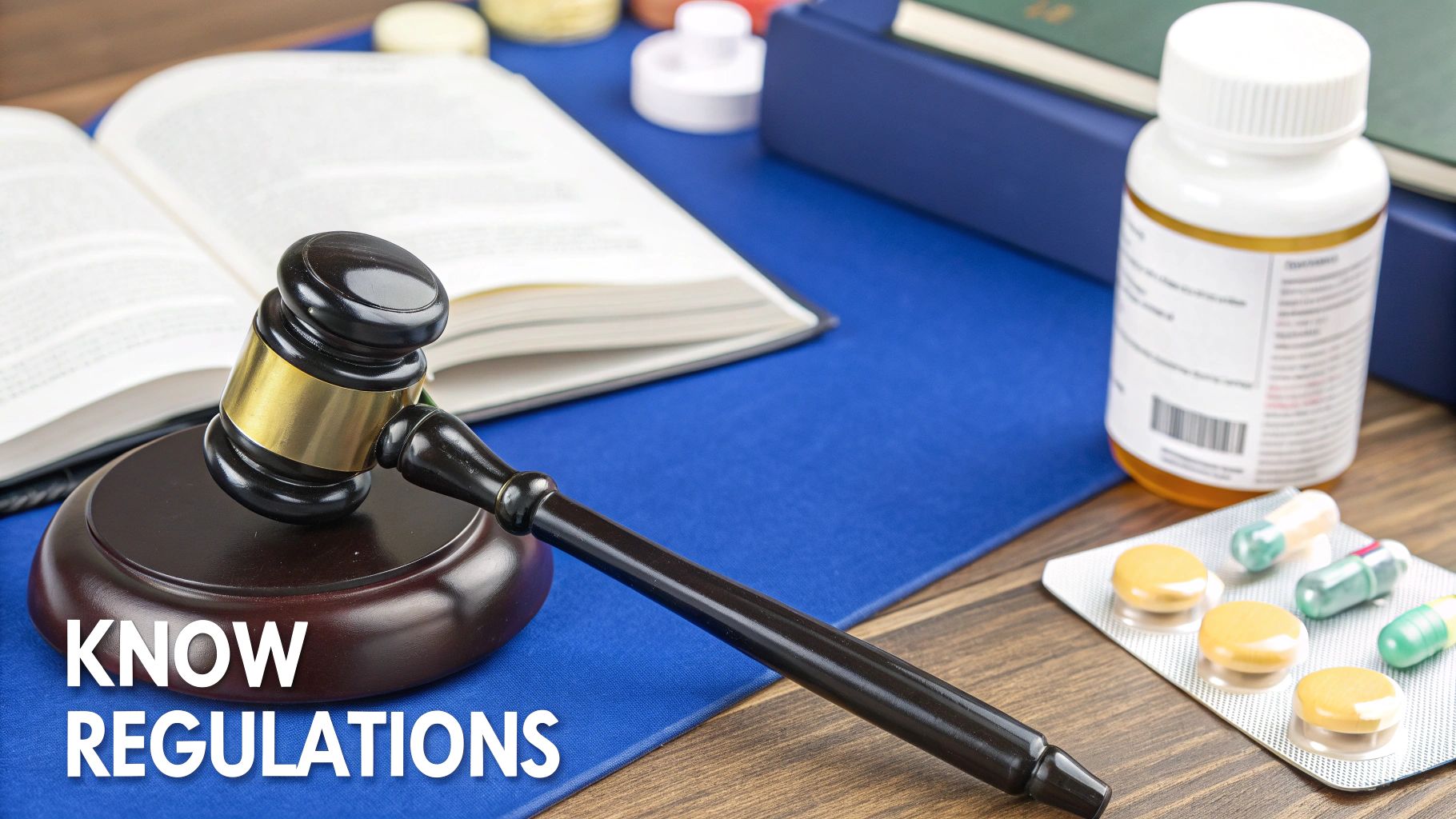
Think of your product’s front label as its first impression. The Principal Display Panel (PDP) is what customers see first on the shelf, and because it’s front-and-center, the FDA has some very specific rules about what needs to go there.
Getting the PDP right isn't just good practice; it's a fundamental step to keeping your product on the market and avoiding regulatory headaches. These dietary supplement labeling guidelines are non-negotiable mandates. Let’s walk through the two critical pieces of information you have to include, so you can avoid common—and often costly—mistakes.
The Statement of Identity
First, your product needs a name that clearly tells people what it is. This is called the Statement of Identity, and it has to answer the basic question: "What am I buying?" A catchy brand name alone won't cut it. You must use the supplement's common name or a clear, descriptive term.
For instance, if you have a product called "Morning Spark," that’s not enough information for a consumer. You have to clarify what it actually does.
-
This works:
- Morning Spark
- Herbal Energy Supplement
-
This doesn't:
- Morning Spark (by itself)
This statement needs to be one of the most prominent text elements on your PDP. It doesn't have to be the absolute biggest font, but it must be bold and impossible to miss.
A common trip-up for new brands is getting so excited about a flashy trade name that they bury the required descriptive statement. The FDA's priority is consumer clarity, not your marketing flair. Make sure the Statement of Identity is immediately obvious.
The Net Quantity of Contents
The second mandatory item is the Net Quantity of Contents. This tells your customer exactly how much product they're getting. The placement and format here are just as rigid as the information itself.
You have to place this statement within the bottom 30% of the PDP, and it must run parallel to the base of the package. It’s also required to be in both metric (like grams, milligrams, or milliliters) and U.S. Customary units (like ounces or fluid ounces).
Here’s a quick cheat sheet for different product types:
| Product Type | Correct Format Example | Common Mistake |
|---|---|---|
| Powders | Net Wt. 10.6 oz (300 g) | Using only "300g" |
| Capsules | 90 Capsules | Not stating the capsule count |
| Liquids | 8 fl oz (237 mL) | Listing "8 ounces" instead of "fl" |
For liquid supplements, precision is everything. I’ve seen brands get flagged just for using "oz" instead of "fl oz." It's a small detail, but it matters. If you're working with tinctures or other liquid formulas, you have to be extra diligent. For a deeper dive into the unique challenges of liquids, our guide on private-label liquid supplements is a great resource.
Balancing Branding and Compliance
The real challenge is fitting these strict requirements into a label design that's still attractive and compelling. It’s absolutely a balancing act. Your branding—the colors, logos, and marketing copy—has to work around the mandatory text, not overshadow it. Don’t try to squeeze the regulatory info in at the end; design with it in mind from the very beginning.
A good way to approach this is to map out your PDP like a grid. The top can feature your brand and logo. The middle is a great spot for your Statement of Identity. The bottom 30% is then reserved exclusively for the Net Quantity of Contents. Planning your layout this way helps you stay compliant without killing your design.
Once your design is locked in, the final step is to bring it to life by working with a quality service for packaging labels printing. A professional printer will help ensure everything is legible and the final product looks as good in hand as it did on screen.
How To Build an Accurate Supplement Facts Panel
The Supplement Facts panel is the absolute heart of your label. Frankly, it’s also where most brands stumble. This isn't just a list of what's inside the bottle; it's a precisely formatted, legally required component that has to be perfect.
Get it right, and you’re demonstrating transparency that builds real consumer trust. Get it wrong, and you could be looking at an immediate FDA warning letter. The entire thing follows strict dietary supplement labeling guidelines, covering everything from the thickness of the lines to the specific fonts you can use.
Let's walk through how to build this panel correctly, starting with the basics and moving into the trickier situations you’ll inevitably face.
Serving Size and Servings Per Container
First things first: you have to define the Serving Size. This is the recommended amount of your supplement someone should take at one time. It needs to be listed in familiar household units, like "2 Capsules" or "1 Scoop (15g)," with the metric equivalent right there beside it.
Right below that, you need to list the Servings Per Container. This one's simple math: just divide the total net quantity of your product by the serving size. So, if your bottle has 90 capsules and your serving size is 2 capsules, your "Servings Per Container" is 45. These two details must sit at the very top of the panel, just under the "Supplement Facts" title.
Your serving size isn't just a casual suggestion—it's the foundation for all the nutritional data that follows. Every single nutrient value in the panel must reflect what’s in one serving. Be realistic and base it on how you genuinely expect a customer to use your product.
Listing Your Dietary Ingredients
Now for the main event: the ingredient list. The FDA is incredibly specific about the order and format here. You are required to list any dietary ingredient present in a "meaningful amount," which typically means any nutrient that has an established Daily Value (DV) or is part of a proprietary blend.
Here’s the mandatory order you have to follow:
- Macronutrients: This includes total calories, total fat, saturated fat, trans fat, cholesterol, sodium, total carbohydrate, dietary fiber, total sugars, added sugars, and protein.
- Vitamins: Start with Vitamin D, then list all other vitamins alphabetically (e.g., Vitamin A, Vitamin C, Vitamin E).
- Minerals: Start with Calcium, Iron, and Potassium, then list all other minerals alphabetically (e.g., Magnesium, Zinc).
For every ingredient, you must list the quantitative Amount Per Serving in metric units (like g, mg, or mcg) and the % Daily Value (%DV) if one exists. Those two columns are completely non-negotiable.
This next flowchart really drives home the critical checkpoints for your entire label, making sure you nail the accuracy from ingredients all the way to the final allergen warnings.
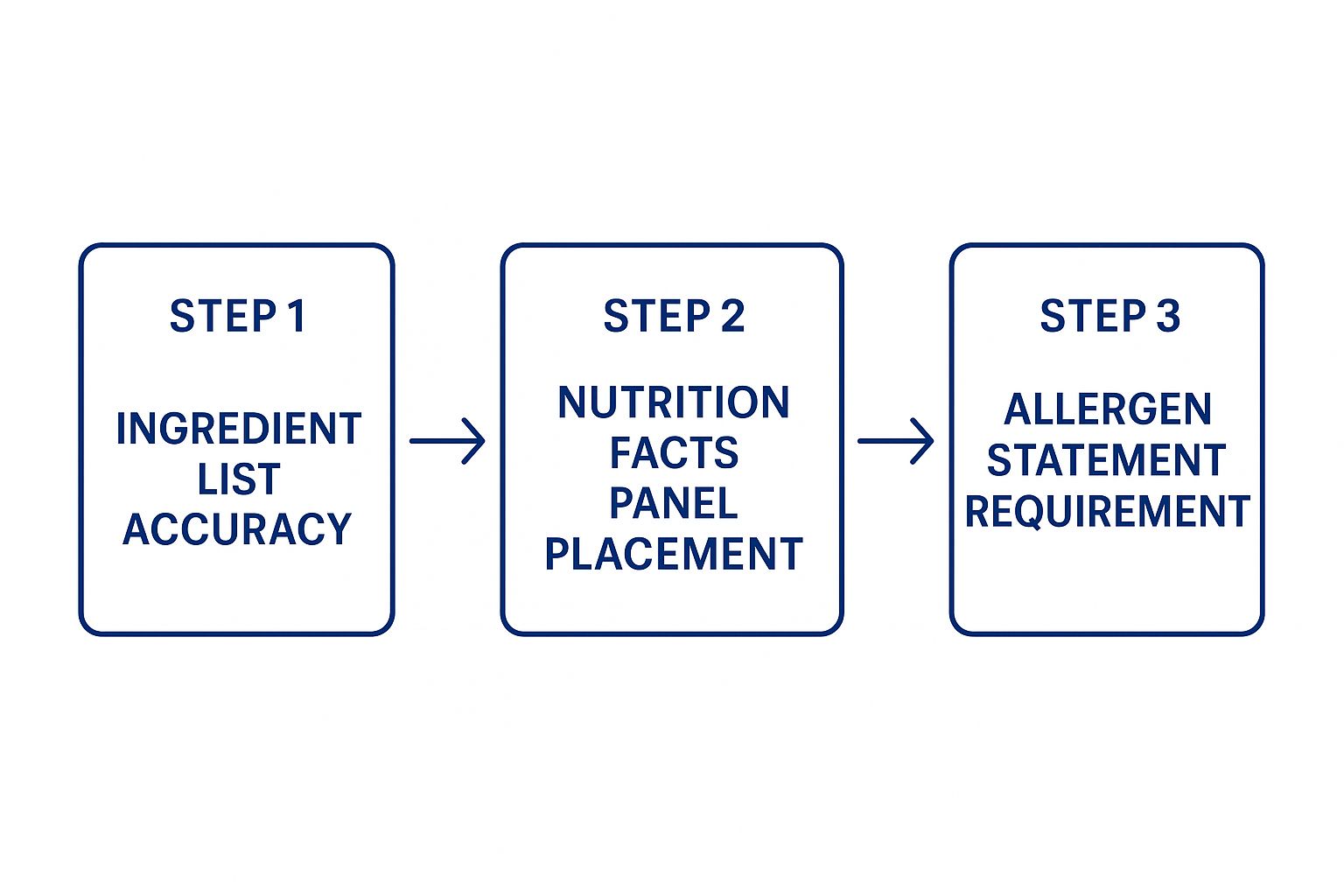
As you can see, a compliant Supplement Facts panel is built on a foundation of accurate ingredient data and correct placement, which then flows right into the allergen statement.
How to Handle Proprietary Blends and Other Ingredients
Proprietary blends are pretty common in this industry, but they come with their own rulebook. You have to give the blend a descriptive name (something like "Energy and Focus Blend") and list the total weight of that blend per serving.
Then, you must list every ingredient inside that blend in descending order by weight. You don't have to disclose the specific amount of each individual ingredient—that’s the whole point of a proprietary formula. But you absolutely have to declare what's in it.
After all your dietary ingredients are listed, you add the "Other Ingredients" section. This is where you list everything else used in the manufacturing process that isn't considered a dietary ingredient. Think of things like:
- Fillers (e.g., microcrystalline cellulose)
- Binders (e.g., stearic acid)
- Colors
- Flavors
- Sweeteners
- Capsule materials (e.g., gelatin, hypromellose)
Just like with blends, these must be listed in descending order by weight. Total transparency is the name of the game here.
Critical Formatting Rules You Cannot Ignore
The look and feel of the Supplement Facts panel is just as regulated as its content. I've seen brands get tripped up by tiny formatting mistakes that render their whole label non-compliant.
To help you avoid those common pitfalls, here’s a breakdown of the must-have elements and the mistakes I see people make all the time.
Required Components of the Supplement Facts Panel
A summary of the non-negotiable elements and formatting rules required for a compliant Supplement Facts panel as per FDA guidelines.
| Component | Requirement | Common Mistake |
|---|---|---|
| Title | Must state "Supplement Facts" in a large, bold font. | Using "Nutritional Facts" or other creative variations. |
| Serving Info | Must be placed at the top, directly under the title. | Burying serving size details at the bottom of the panel. |
| Lines | A heavy bar must separate the serving information from the nutrient list. A lighter bar separates nutrients. | Using lines of the same thickness throughout the panel. |
| Footnote | The %DV footnote ("*Percent Daily Values are based on a 2,000 calorie diet.") must appear at the bottom for labels with %DV information. | Omitting the footnote or altering its official wording. |
| Font Size | Minimum type size for most text is 6-point, with some flexibility for smaller packages. The title should be larger. | Using fonts that are too small to be legible on the package. |
| Type Style | Use a mix of bold and regular type as specified. For instance, "Total Fat" is bold, but "Saturated Fat" is indented and not bold. | Bolding every single line item, which directly violates formatting standards. |
Navigating these details is a meticulous process, no doubt about it. But when you break it down into these distinct parts—serving size, ingredient listing, blend declaration, and final formatting—you can build a Supplement Facts panel that is accurate, transparent, and most importantly, fully compliant with FDA dietary supplement labeling guidelines.
Listing Ingredients and Allergens Correctly
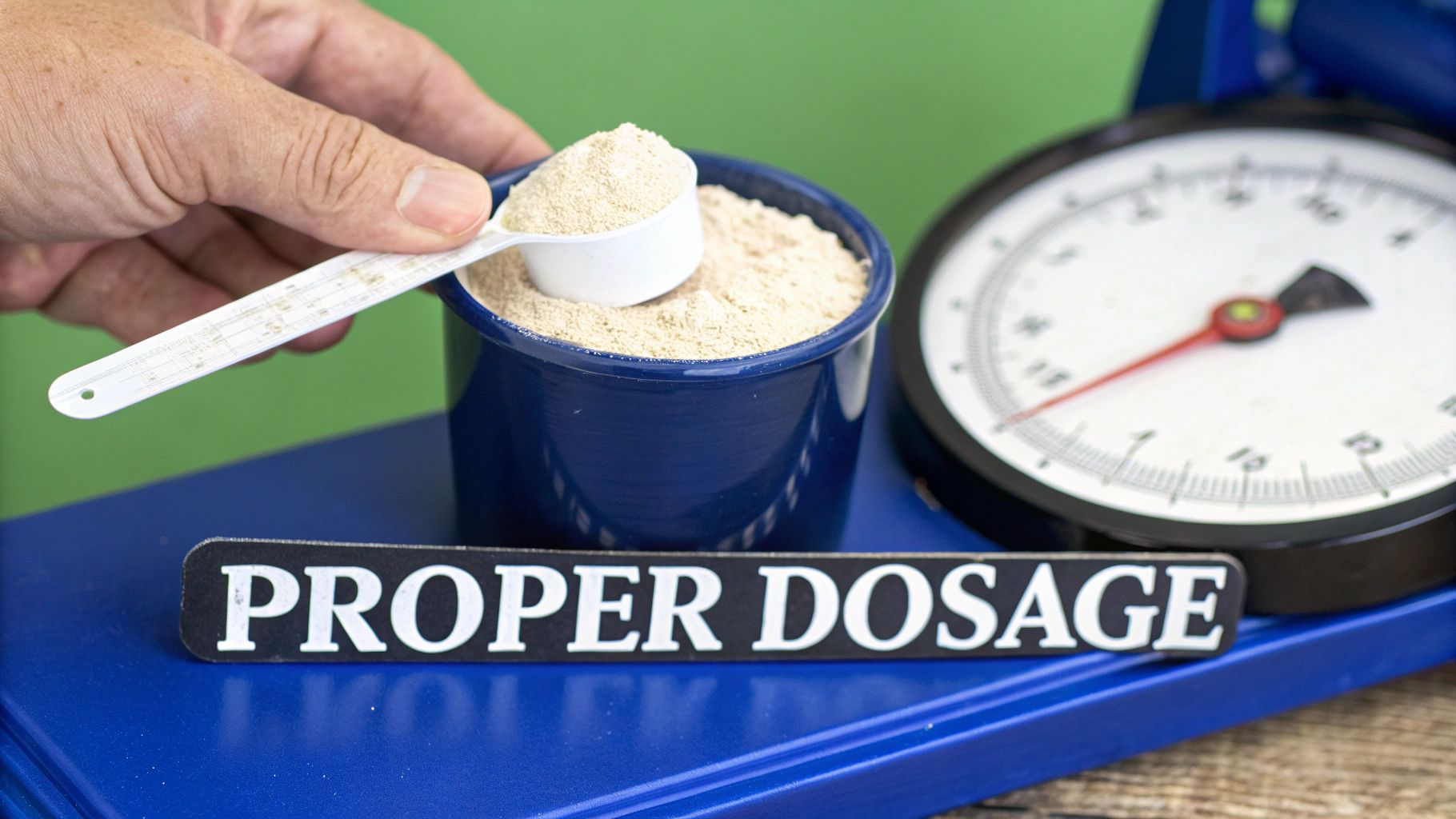
Alright, we've covered the Supplement Facts panel, but right next door is another area where the details matter immensely: the ingredient list and allergen warnings. This is where you lay all your cards on the table, disclosing every single component of your product.
Frankly, getting this section wrong is one of the fastest ways to land in hot water and trigger a product recall. It’s where consumers look for the final details they need to make safe choices.
The FDA's dietary supplement labeling guidelines are clear: you must list your ingredients either directly inside the Supplement Facts panel or immediately below it. If you have "Other Ingredients"—things like fillers, binders, or the capsule itself—they get their own list right after the panel.
The golden rule here is simple: list everything in descending order by weight. The ingredient that makes up the most of your formula goes first, and the one that weighs the least goes last. This is a non-negotiable principle that shows customers the true composition of what they’re buying.
Mastering the "Other Ingredients" List
Let's talk about that "Other Ingredients" list. This section often includes the unsung heroes of your product—the functional components that make your supplement stable, effective, and easy to consume. Every single excipient must be declared here.
I'm talking about things like:
- Fillers: Microcrystalline cellulose is a common one used to add bulk.
- Binders: Ingredients like stearic acid are what hold a tablet together.
- Flow Agents: Think silicon dioxide, which keeps powders from clumping up.
- Capsule Materials: This could be gelatin (animal-based) or hypromellose (a plant-based alternative).
- Flavors and Sweeteners: Any natural flavors or sweeteners like stevia must be listed.
Even if you’re using trace amounts, every ingredient must be listed by its common or usual name. For example, use "gelatin," not some technical chemical name nobody recognizes. This transparency is absolutely vital for people with dietary restrictions, like vegans who need to avoid animal products.
Navigating the Food Allergen Labeling and Consumer Protection Act
This is where things get serious. One of the most critical parts of your label is complying with the Food Allergen Labeling and Consumer Protection Act (FALCPA). This act is no joke—it mandates the crystal-clear labeling of the nine major food allergens, which cause the vast majority of serious allergic reactions in the U.S.
The nine major allergens you must know are:
- Milk
- Eggs
- Fish
- Crustacean shellfish
- Tree nuts
- Peanuts
- Wheat
- Soybeans
- Sesame
If your product contains any of these, you must declare them in plain English. The FDA gives you a couple of ways to do this, but from my experience, one method has become the industry gold standard because it's impossible to misinterpret.
The most straightforward and highly recommended approach is to use a "Contains" statement. This statement should appear immediately after or right next to the ingredient list and must list every major allergen present in the product.
Let's say your formula uses whey protein (from milk) and lecithin (from soy). Your allergen statement would be simple and direct.
Compliant Example:
Contains: Milk, Soy.
This leaves zero room for error. A customer with a severe milk allergy doesn't have to be a supplement expert to know that "whey" is a milk derivative; your "Contains" statement tells them what they need to know at a single glance.
The other option is to declare the allergen in parentheses right in the ingredient list, like Ingredients: Whey protein (milk), Lecithin (soy), .... While this is technically compliant, it’s much less user-friendly and can be easy for a consumer to miss. Stick with the separate "Contains" statement. It's best practice for a reason.
Avoiding Common Allergen Pitfalls
So, where do brands usually trip up? The biggest mistake I see is failing to identify "hidden" allergens in raw materials. You'd be surprised. A botanical extract might use a soy-based carrier you didn't know about, or a proprietary flavor blend could contain wheat.
It is 100% your responsibility to know the full composition of every single ingredient you source from your suppliers.
Always, always demand a certificate of analysis (COA) from your suppliers that details all sub-ingredients and potential allergens. Skipping this step isn't just a labeling mistake; it's a serious safety hazard. An undeclared allergen is a leading cause of FDA-mandated recalls, which can destroy a brand's reputation and cost a fortune. By doing your homework and using clear, compliant "Contains" statements, you protect your customers, and you protect your business.
Navigating Structure/Function and Health Claims
The claims you make on your label are a regulatory minefield. Seriously. This is where your marketing team's enthusiasm can run headfirst into a brick wall of strict FDA rules. Getting this part wrong isn't just about getting a warning letter—it can redefine your product as an unapproved drug, opening the door to some pretty severe legal and financial pain.
You absolutely have to understand the fine lines between the three main types of claims. It’s one of the most critical parts of creating a compliant label. Let's break down the rules for each so you can market your product effectively without accidentally making illegal disease claims.
Differentiating Claims: Structure/Function vs. Health
The most common claim you'll see on a supplement is a structure/function claim. Think of it as describing what a nutrient or ingredient does for the normal, healthy human body. A classic example is "calcium builds strong bones." It's simple, direct, and talks about a normal bodily function.
But there’s a huge catch. If you use a structure/function claim, you are legally required to include the mandatory DSHEA disclaimer on your label. This isn't optional, and the wording is exact:
"These statements have not been evaluated by the Food and Drug Administration. This product is not intended to diagnose, treat, cure, or prevent any disease."
On top of that, you have to notify the FDA of the exact wording of your claim within 30 days of bringing your product to market. This is just a notification, not a request for approval. You're telling them what you’ve done, not asking for their blessing.
Health claims, on the other hand, are a whole different ballgame. They're much more powerful because they explicitly connect a substance to a reduced risk of a disease or health condition. Because they mention a disease, they get dangerously close to being a drug claim, which is why the FDA watches them like a hawk.
There are two main types of health claims you should know:
- Authorized Health Claims: These are the gold standard. They have what the FDA calls "significant scientific agreement" and have been officially approved. The link between folic acid and a reduced risk of neural tube defects is a perfect example. There are very few of these.
- Qualified Health Claims: These are backed by some scientific evidence, but it's not considered conclusive yet. If you use one, you must include a qualifying statement that spells out the level of scientific support, like, "Supportive but not conclusive research shows that..."
Understanding Nutrient Content Claims
The third category is nutrient content claims. These statements are all about the level of a nutrient in your product. They seem straightforward, but they come with very specific thresholds you must meet. You can’t just throw "high in Vitamin C" on your label unless it actually is, according to the FDA's definition.
Here are a few of the most common terms and what they really mean:
| Claim Term | FDA Requirement |
|---|---|
| High / Rich In / Excellent Source Of | Contains 20% or more of the Daily Value (%DV) per serving. |
| Good Source Of / Contains / Provides | Contains 10-19% of the Daily Value (%DV) per serving. |
| Low Calorie | Contains 40 calories or less per serving. |
| Fat-Free | Contains less than 0.5 grams of fat per serving. |
These terms give consumers a quick snapshot, but they are legally defined. Using them incorrectly is a clear labeling violation and an easy way to get into trouble. For anyone selling online, getting these claims right is even more critical, since platforms like Amazon have their own automated compliance checks. If you're navigating that world, you might find our guide on how to sell supplements successfully on Amazon helpful, as it touches on these marketplace-specific hurdles.
It's also fascinating to see how these rules stack up internationally. In Europe, supplement labeling is governed by the European Commission (EC), which is also laser-focused on nutrient and health claims. The EC has a "positive list" of approved vitamins and minerals, and they specify both maximum and minimum amounts. A claim like 'high in vitamin C' is allowed, but the process for getting new health claims approved can be incredibly long and expensive, a point of contention for many industry groups. You can get more insights on these international supplement regulations at BurdockGroup.com. This global view really highlights how nuanced and complex supplement labeling can be from one market to the next.
Thinking of taking your supplement brand global? It's an exciting prospect, but be warned: you're stepping into a whole new world of regulatory compliance.
The idea that you can create one "global label" and just translate the language is a complete myth. A label that's perfectly buttoned-up and FDA-compliant in the United States could get you into serious trouble in Canada or the European Union. These aren't just minor differences in font size or wording. We're talking about fundamental disagreements on what ingredients are even allowed, what you can claim they do, and how they're classified.
Getting this wrong is a fast track to disaster. You could face costly rebranding, see your products seized at customs, or be shut out of a market entirely.
How Canada's NHP Framework Changes Everything
Let's look at our neighbor to the north, Canada. You might think it'd be similar to the U.S., but its regulatory approach is worlds apart. Canada doesn't regulate supplements under food laws like the U.S. does with DSHEA. Instead, they’re classified as Natural Health Products (NHPs) and fall under the strict oversight of Health Canada.
What does this mean for you? Every single NHP has to go through a pre-market review and get a Natural Product Number (NPN) before it can hit Canadian shelves. That NPN must be on your label. This is a massive departure from the U.S. model, where you simply notify the FDA after your product is already on the market. In Canada, they scrutinize your product's safety, quality, and efficacy before it ever reaches a consumer.
On top of that, the claims you can make are held to a much higher standard. A simple structure/function claim in the U.S. might need a mountain of scientific evidence to be approved as a therapeutic claim in Canada. This completely changes how you have to position and market your product.
The Maze of the European Union and China
The European Union throws another wrench in the works. While the EU has managed to harmonize rules for vitamins and minerals through the European Food Safety Authority (EFSA), its approach to botanicals is notoriously fragmented. An herbal ingredient that's perfectly fine in Germany might be restricted or even banned next door in France. It’s a true patchwork.
And then there's China. Its system is arguably the most unique and challenging. Supplements there are often split into two camps: registered "blue hat" products that can make specific health claims, and standard food supplements that are simply filed and can't make any claims. That "blue hat" registration is a famously brutal process, often taking years and a significant financial investment to complete.
The bottom line is that this global regulatory mess is a huge hurdle for any brand looking to expand. There's no single international treaty that governs what a supplement is or how it should be labeled, which makes international trade incredibly complex.
A 2021 analysis comparing U.S., Canadian, Chinese, and European regulations confirmed just how fragmented the landscape is. It highlighted how the EU’s lack of consistent rules for botanicals makes it nearly impossible to create a single product for the entire region. You can read a deeper analysis of these regulatory differences to understand the full scope of the challenge.
The only way to succeed is to treat each new country as a brand-new project. You have to start your labeling process from scratch every single time, digging deep into that country's specific dietary supplement labeling guidelines. Assuming your U.S. label will fly elsewhere isn't just a simple mistake—it's a recipe for failure.
Ready to create a liquid supplement with a compliant, market-ready label from day one? The team at Triton Nutra Group has over 25 years of experience navigating complex FDA and e-commerce regulations. We guide you through every step, from formulation to final packaging, ensuring your product is set up for success. Learn more at Triton Nutra Group.